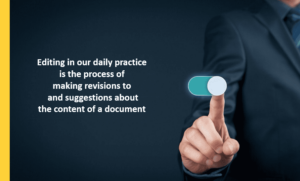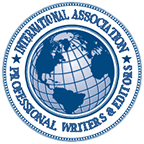
This includes improving the accuracy of language, the flow, the organisation and structure, the condensation and the overall readability of the text. It also involves checking for grammatical and spelling errors like in proofreading, just editing takes a deeper look at how information and ideas are presented.
We found there is always room for improvement, and with our Editing we turn a good text into a great one. Hence, a document should be edited at least once before it is proofread.
As you will find below, we have broken down our editing services into six categories.
However, editing and publishing today embrace such a variety of ever-changing processes, services and providers that it is no wonder the field suffers from a lexicon with rather ambiguous terms.
If you were hoping to finally figure out here the difference between substantive editing and stylistic editing, for instance, we must disappoint you because there just are no industry-wide definitions of editing types that everyone would agree on.
Even the bastions of the editorial industry cannot even agree on whether to spell the term ‘copyediting’, ‘copy-editing’, or probably ‘copy editing’.
So how do you talk to an editor about what your text needs if you can’t even be sure you’re talking about the same services?
The potential for confusing terminology and misapprehension notwithstanding, the crucial necessity is in fact that both client and editor understand the task and instructions in the same way.
With clear communication as our goal, in the following, we are offering our definitions of the various editorial functions that we at AVALON carry out. It is what each service means in our proven practice. Please do not consider these definitions universally definitive.
We will advise you and always clarify with you in detail what should be carried out on your project. In order to avoid confusion at a later stage, we will agree with you exactly what our editing remit will encompass.
Kindly be aware that any of our service descriptions here are just a general outline.
Upon genuine further interest on your part, we will be happy to provide you with more detailed information and work out a specific proposal tailored to your needs.

AVALON’s various Specialist Editing categories:
• Project Editing
• Substantive Editing
• Stylistic Editing
• Copyediting
• Production Editing
• MTPE / AITPE
“Passion for precision”
Project Editing
Project Editing can take on many different meanings depending on what needs to be edited. It may involve just looking over the timeline or up to full scheduling for project completion and making the necessary adjustments.
As project editors, we can manage the entire project and may appoint all members of the editorial team. The process might also entail development responsibilities.
The following are typical project editor duties:
• Scheduling and tracking
• Reviewing all aspects of the editorial process and enforcing consistent standards throughout
• Ensuring communication among all members of the editorial team, including the designer and any illustrators
Development aspects may include consultation before the writing begins, help in planning the organisation, features, and other aspects of the work, preparation of developmental reviews or analyses, and the following:
• Suggesting formats to communicate the message
• Rewriting and restructuring existing text to fit the format
• Identifying gaps in content, and creating copy as needed
• Moving entire paragraphs and sentences to improve the flow
• Ensuring consistent structure by adding or deleting headings
• Determining the style and general content of any illustrations/diagrams
• Deleting content that is outdated, superfluous or that does not achieve the desired focus or tone
All of this means looking at the big picture of the project, helping plan the design, structure and outline of the manuscript. This process is the most time-consuming phase of the whole editing.
AVALON Project Editing provides a valuable objective look and overview, development, guidance, and support through the writing or rewriting process.
Substantive Editing
Substantive Editing is the most intensive form of editing and the first step in the actual editorial process. Some also appear to call it Content Editing, Structural Editing, or Comprehensive Editing.
Anyway, AVALON Substantive Editing deals with the general organisation and presentation of the text, as well as the content itself to make it clear, coherent, engaging, and complete. The process evaluates the overall style, content and formatting of the document in order to optimise its visual design and comprehensibility. At this stage, we are not concerned with grammar and spelling.
Substantive Editing is complex and subjective. It aims to ensure that the structure, content, language, style, and presentation of the document are suitable for its intended purpose and readership. Not all texts require the same amount of Substantive Editing, but most can benefit significantly from the critical eye of a substantive editor.
• Substantive Editing begins with an analysis of who will use the document and for what purpose.
Then it moves on to improving the manuscript in any or all of the following ways:
• Identifying and solving problems of overall clarity or accuracy
• Ensuring the information is complete and appropriate, and determine whether additional material or reader aids
(such as illustrative material, glossary, or index) are required
• Reorganising paragraphs, sections, or chapters to improve the order in which the text is presented
• Ensuring the document contains appropriate navigation aids, such as headings or internal links
• Assigning new levels to headings in order to achieve the most logical structure
• Smoothing transitions and moving sentences to improve readability
• Writing or rewriting segments of text (only) to improve readability and flow of information
• Suggesting and sometimes implementing additions and deletions, noting them at sentence and paragraph-level
• Revising any or all aspects of the text to improve its overall presentation
• Consulting with others about issues of concern
• Incorporating responses to queries and suggestions in creating a new draft of the document
Once the Substantive Editing is complete, the document is – if applicable – off to the writer for revisions, before being passed on to our Stylistic Editing, Copyediting and Proofreading teams later on.
Stylistic Editing
Stylistic Editing, also called Line Editing, gets down to the nitty-gritty, looking at every sentence, and checking the choice of every word. We may cut superfluous words and make sentences more concise. The focus of AVALON Stylistic Editing here is always on the style and tone of the writing.
• Checking that the presentation is simple and effective
• Ensuring language and form are appropriate to the readership
• Ensuring information and arguments are presented clearly and unambiguously
• Deleting any unnecessary repetitions, as well as redundancies and contradictions
• Correcting incorrect word usage
• Eliminating wordiness, triteness, repetition, and inappropriate jargon
• Improving awkward phrasing
• Enforcing consistency in tone and writing style
• Ensuring consistency in spelling, hyphenation, numerals, fonts, and capitalisation
• Ensuring document title and all headings accurately reflect content
• Ensuring that previews, summaries, and end-of-chapter questions reflect content
• Ensuring appropriate referencing is included
• Cross-checking references, lists, tables, figures, equations, and other features for consistency
with their mentions in the text
• Checking placement, clarity and sequencing of lists, tables, figures and other illustrative material, also
checking against textual references
• Ensuring that explanations of symbols, abbreviations, and terms are incorporated in the text or glossary
• Preparing a style sheet that documents style and format
Now the document is ready for Copyediting.
Copyediting
Where with Stylistic Editing we ensure that the writing is “polished”, Copyediting makes the writing clean and correct. It aims to achieve overall accuracy, clarity, and consistency in a document. Therefore, the process scrutinises grammar, spelling, punctuation, syntax, and word usage. It also checks for internal consistency of facts and style.
The process namely is about:
Appropriate use of language:
Correcting faulty spelling, grammar, and punctuation
Checking for correct and appropriate:
• Grammar
• Syntax
• Spelling
• Punctuation
• Clarity of expression
This might include some rewording of sentences just to ensure that the meaning is clear.
Consistency:
• Language consistency – ensuring consistency in terms of:
• Language and structural parallelism
• Terms used
• Spelling
• Capitalisation
• Hyphenation
• Abbreviations
• Expression of numbers and quantitative data
• References
• Visual consistency – ensuring consistent and appropriate format in terms of:
• Typography
• Heading hierarchy
• Page layout
• Figures
• Tables and captions
Accuracy:
• Verifying the accuracy of dates, model numbers, quotations, and hypertext links
References:
• Checking accuracy of cross-references within text / between text and figures / between lists of contents and body of document
• Ensuring conformity and completeness in textual and bibliographic references and citations
• Confirming sources have been acknowledged and copyright law has been followed
Conformity with style sheet:
• If no house style has been set yet, our editors will, in consultation with you, adopt or devise a style sheet that is internally consistent and in line with accepted practice.
With every finished manuscript, it is important to meticulously and systematically go through it and retrieve those mistakes. No matter how confident even an experienced writer is that the text is mistake-free, highly likely there are mistakes in there. A lot of data is available on this, but it is believed that average people only detect about 60 percent of errors, and even professionals usually only catch about 85 percent.
That’s why Copyediting and the next stage of editing, the Proofreading, should be in tandem.
The kinds of mistakes we catch with AVALON Copyediting are not life-threatening, however, they make the difference between a professional text and one that comes across as amateur.
Production Editing
In Production Editing, we don’t focus on the words as much as the technical aspects of developing a manuscript into a “publishable product”. Production editors are responsible for the process of putting out a publication, overseeing the production processes and content of publications.
This challenging task spans from the final manuscript through to print-ready files. It includes many duties and requires vast experience as an editor, a bachelor’s degree, and proven managerial skills because in many ways, this is project management.
AVALON production editors are passionate and don’t mind working in a stressful, fast-paced office setting, with sometimes long, unusual hours to meet strict deadlines. Much of their work is done on computers, reviewing content, making edits, and collaborating with contacts electronically. They often balance several projects simultaneously, while managing other staff members and ensuring goals are met on time and on budget.
Production Editing involves managing the entire production process from manuscript status to the finished product, including:
• Scheduling and tracking the entire production process
• Planning a publication’s budget, incl. paying vendors, contracted providers and any freelancers, also keeping a log of expenses
• Negotiating contracts with service providers, such as illustrators, photo researchers, permissions researchers, designers or
typesetters, and awarding work
• Commissioning and managing service providers and hired freelancers
• Appointing and supervising the team of editors and designers
• Incorporating the author’s replies to queries
• Reviewing material, and finalising published materials
• Ensuring the quality of typography, layout, and manufacturing
• Executing administrative procedures (such as registration of copyright)
Whether you are a client from the publication industry – be it a newspaper, magazine, Web publication, publishing company and broadcasting station – or a corporate or private client, we will ensure that your product will have a shiny, pleasing and professional appearance at the publishing date.
A note of well-meant advice: If you’ll be self-publishing, a book for instance, you will most likely need complete editing to create a competitive commercial title. Your work will be in direct competition with thousands of professional-calibre books, produced by career writers and editors. Self-publishing means assuming the responsibilities of a traditional publisher yourself. It does not mean that you can expect success from offering a Do-It-Yourself project for sale in a professional marketplace.
If you don’t have a huge budget for a fully comprehensive edit, we should be able to find alternatives to help you reach your publishing goals on your budget to still get you across the finish line with a professional product.
Machine Translation Post-Editing (MTPE) / AI Translation Post-Editing
On our page Translation we already briefly touched on the highly topical matter of Machine Translation (MT).
By using state-of-the-art and market-ready technologies, translations can today actually be produced at the touch of a button to some level of quality and at a lower cost. The system landscape and progress of neural machine translations, which function like a human brain using neural networks, are in fact improving continuously. The performance of these MT systems now is not anything like the clumsy-sounding, usually rather odd machine results of days gone by. However, while many companies and individuals assume that machine translation is reasonably on-point, it often leaves a bit to be desired when it comes to accuracy. After all, the automatic and unpolished process produces just a basic output that is by itself not suitable for serious use and rather needs human input to achieve a professional text.
Remember, MT itself is not so bad when you are just trying to understand that short social media post from English to German for example. But, it could definitely get super-risky for your brand if you probably rely on nothing else than MT for translating your business materials. Low-quality machine translation holds the potential to cause an undesired reputation crisis at any moment.
When combined in a smart way with translation memory, terminology and human linguistic skills though, such machine translations form as kind of raw translation an excellent framework for increasing translation productivity many times over.
Machine Translation + Post-Editing together (commonly known as MTPE) is what makes this integration possible. Today, with the increasing use of AI it is also referred to as AITPE (AI Translation Post-Editing).
MTPE represents an intelligent hybrid translation solution in which human linguists edit the output of advanced machine translation to refine the text and improve its quality.
In essence, it means combining machine output and human touch for the best of both worlds.
In this, ‘MT’ is the technical foundation and ‘PE’ the essential difference.
While our five traditional editing services detailed above refer to fixing errors in human-translated content, the post-editing in MTPE / AITPE is different from this regular editing in that it specifically refers to the editing of machine-/AI-translated content.
MTPE / AITPE requires a high level of understanding of the functions and objectives of machine translation as well as comprehensive language skills and technical competence.
Our post-editors are experienced professional translators who correct, supplement and standardise the MT result and adapt it to the relevant specialised terminology. This means that the final result is almost no different to a human translation, while at the same time it is a fast and inexpensive, and above all also correct and complete translation that meets all quality, style and terminology requirements, and connects with the target group.
The aim is to use as much of the raw machine raw result as possible and, based on this, to create target text which delivers on the client’s specific requirements and specifications. Normally, time is spent on translation plus editing, now in effect time is only spent on (post-)editing. In order to fully take advantage of these cost and time benefits of MT, the focus is always on economic efficiency.
By now, machine translation with MTPE / AITPE has become an established standard procedure, used across all industries, even for specialist subjects.
Complemented with the post-editor’s expertise and fine-tuning, it has a number of definite advantages:
- Time savings – overall processing time is shortened
- Increased productivity – faster turnaround
- Cost reduction – translation costs are more economical
- High quality – level and natural language result comparable to human translation (human parity)
- Faster market launch – multilingual-information products can be distributed much quicker
- Quantity advantage – larger translation volumes in less time
When you are looking for a cost-effective language solution to process large volumes of content within a short time at assured high quality, this is when you should consider MTPE for your project.
Most of the time, MTPE is the go-to solution for big chunks of Automotive, IT, Electronics and Technical texts because these are relatively repetitive and need to adopt specific terminologies to ensure consistency and familiarity.
Professional MTPE is integrated into a coherent translation process that needs to be optimised to ensure all the benefits mentioned above.
Language service providers must apply the same high-quality standards to MTPE projects as they do to regular specialised translations.
Check comprehensibility, improve readability, correct mistakes and meet targets – these are the main requirements when post-editing a machine translation. An international quality standard for post-editing in the MTPE process has been in place since February 2018 with ISO 18587:2017. As a quality company, it was self-explanatory for us at AVALON that we would run our processes to comply with the standard.
The norm is about standardised quality processes, comprehensively transparent project procedures, including personal consultation, adjustment of the processes, and the highest level of data protection.
It distinguishes between two service types – light post-editing and full post-editing – and defines expectations for each level.
Post-editing strategies depend on the client’s requirements, the nature of the project and the resources available, i.e. time, quality and cost. This information points to which type of approach is more suitable for the project.
Depending on your quality demands, target audience and style, we can offer you light or full post-editing, each affecting the project duration and final product price.
Light post-editing
addresses and corrects any mistranslations, grammar and spelling mistakes, missing translations and inconsistencies affecting the meaning in order to ensure the target text is accurate and comprehensible.
This may include rewriting confusing sentences in part or completely and deleting superfluous or extra translation alternatives generated by the engine.
This is a good approach when time and money are limited, but it will not always be the best choice as it prioritises speed over quality.
Full post-editing
is the more complex form of editing that modifies and refines the AI-generated text in a thorough manner, ranging from accuracy, fluency and style to tone, cohesion and coherence, with the goal that the target text reaches a quality near human output and thus should be indistinguishable from a human translation (“human parity”).
The process involves all of the light editing tasks plus checking terminology against approved terminological resources to make sure it is consistent and appropriate; cross-referencing against other resources; making syntactic modifications in accordance with practices for the target language; producing stylistically consistent fluent content; applying correct formatting and tagging, and correcting all grammatical errors, typos, spelling mistakes and punctuation issues.
The result will be a high-quality translation that may take a little longer but will be adequate to human translation.
Our post-editing is based on a core translation team. In order to enhance the quality of the output, the post-editing process evaluates the errors, records the terminology and provides systematic feedback. These results are essential for re-training the MT systems and for a sustainable MT workflow.
In that respect, one must see the importance of terminology work as a quality factor for subsequent post-editing. Generic MT systems in particular cannot map the specific vocabulary of a company. And even with trainable engines, compliance with terminology is not always guaranteed. Therefore we compile your industry-specific vocabulary and your company-specific corporate language as a terminology base so that people and machines can access it. And rest assured we do not leave translation to chance. Our specific guidelines and style guides help to establish specific rules and style templates for your company and everyone involved in the process – from the source text and linguistic criteria to re-training and workflow definitions.
Optional extra revision following post-editing = “machine + human + human”:
Four eyes are better than two. As with human translations, we offer a revision service performed by a second native-speaker professional for all post-editing projects. This further editing stage compares the source text and target text again and ensures that the terminology and style guidelines have been followed.
We can advise you when and for which texts such additional revision makes sense so that you are always on the safe side linguistically.
From global corporations to medium-sized companies and start-ups, companies from all sectors already benefit from the synergy of technology and human expertise.

Do you also want to become one of the progressive companies using machine translation to increase your productivity?
With the expert creative human touch of our post-editing you can achieve human parity on your machine pre-translations at reduced cost and get your content on the road in no time.
With AVALON by your side you can jump straight into MT without risk and any investing as our scalable MTPE / AITPE full-service solution provides you with faster and more cost-effective translation projects, under complete data-protection, without compromising on the translation quality you expect.
Whatever your specific project and situation, take a look at the various features of AVALON Editing services, and let’s consider together how we can bring clarity to your texts and success to your writing and translations.
Talk to us now. If you are not ready today, bookmark this page and easily find us again later.
![]() “It’s never too late – in writing or in life – to revise”
“It’s never too late – in writing or in life – to revise”



